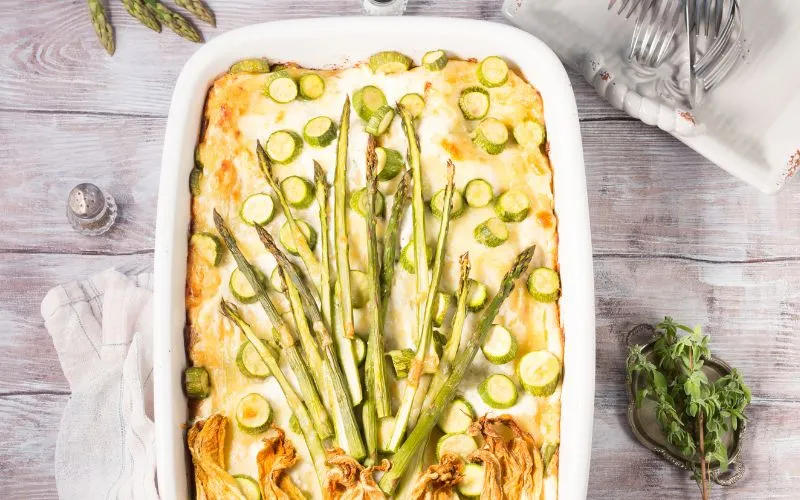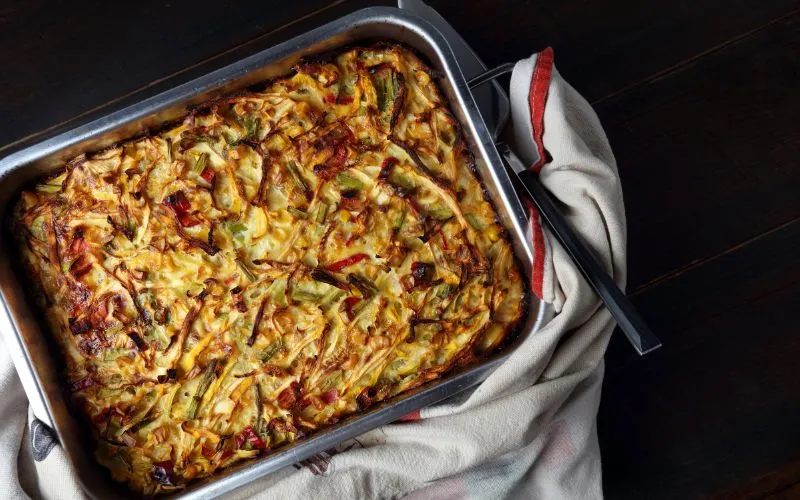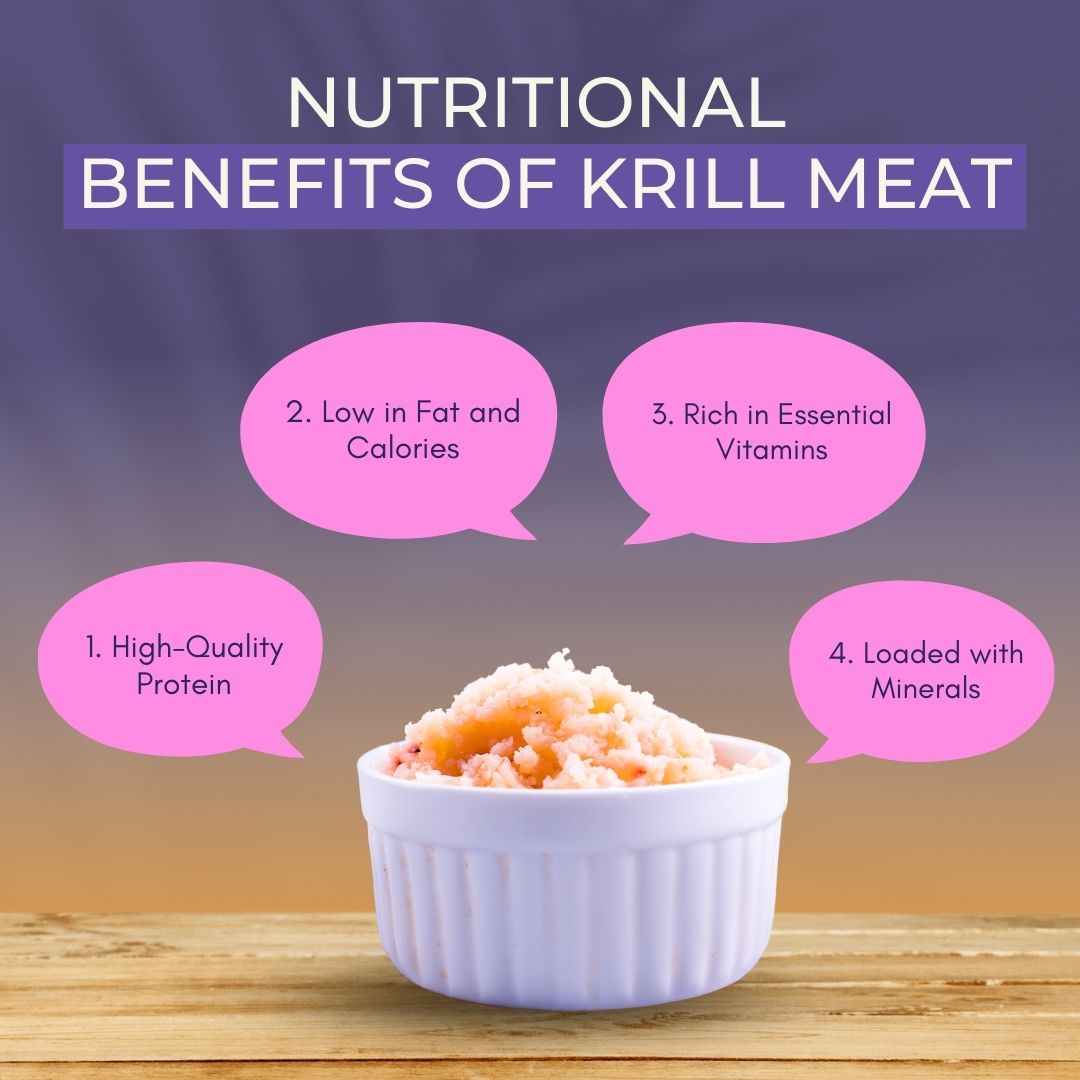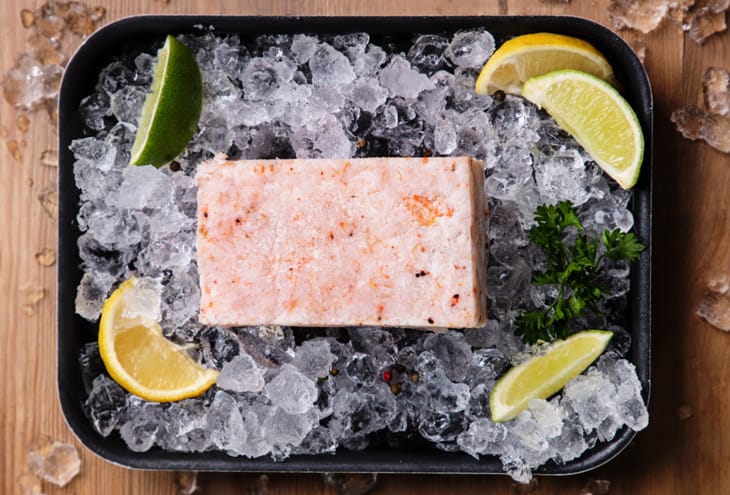Asparagus is more than just a side dish; it’s a nutritional powerhouse. Our Asparagus Casserole recipe adds a twist to this vibrant green vegetable by including nutrient-rich Antarctic krill meat, enhancing its flavour and health benefits. Ideal for festive occasions or a wholesome family dinner, this recipe promises to be a delightful surprise on any dining table.
Recipe Chart
| Aspect | Details |
| Total Prep Time | 30 minutes |
| Cook Time | 15 minutes |
| Serves | 10 |
| Yield | 1 casserole |
| Nutrition Profile | Low-Carb, Nut-Free, Soy-Free, High-Fiber, High-Protein, Egg-Free, Vegetarian |
Health Benefits Of Asparagus Casserole
- Fiber: Enhances digestive health and promotes regularity.
- Vitamins C and E: Vital for immune function and skin health.
- Vitamin K: It is essential for blood clotting and bone health.
- Potassium: Potassium content in asparagus helps to regulate blood pressure and fluid balance.
- Folate: Folate is crucial for cell division and DNA synthesis, making it important for pregnant women.
- Omega-3 Fatty Acids (EPA and DHA): The addition of krill meat in this recipe has a high profile of omega-3 fatty acids, which are crucial for maintaining heart health by reducing triglycerides, lowering blood pressure slightly, and reducing blood clotting. They also support brain health by aiding in neurotransmitter function and providing the building blocks for brain cells.
Ingredients You Need For Asparagus Casserole
- 3 tablespoons unsalted butter, divided
- ½ cup whole-wheat panko breadcrumbs
- 3 pounds of asparagus, trimmed and cut into 2-inch pieces
- 1 tablespoon finely chopped garlic
- 2 tablespoons all-purpose flour
- 2 cups whole milk
- 5 ounces cream cheese
- ½ cup shredded part-skim mozzarella cheese
- 1 teaspoon salt
- 100 grams of krill meat, finely chopped
Instructions
- Preheat your oven to 450°F. Bring a large pot of water to boil and a bowl of ice water to a boil.
- Mix the 1 tablespoon of melted butter with the breadcrumbs in a bowl. Set aside.
- Cook the asparagus in boiling water until bright green, about 1 minute. Drain and immerse in ice water. After 5 minutes, drain and pat dry.
- Place the asparagus and krill meat in a 9-by-13-inch baking dish, mixing slightly to distribute the krill evenly.
- In the same pot, melt the remaining butter, add garlic, and sauté until fragrant. Sprinkle in flour and stir for 30 seconds. Gradually whisk in milk, boil, and cook until thickened. Remove from heat and incorporate the cheeses and salt.
- Pour the cheese sauce over the asparagus casserole and krill, mixing well. Top with the breadcrumb mixture.
- Place in the oven and bake until the asparagus is tender, about 12 to 15 minutes.
Steps To Make Asparagus Casserole Ahead Of Time
You can prepare this casserole through step 5 and refrigerate it for up to 2 days. Allow it to come to room temperature as you preheat the oven.
Health Risks Associated With Asparagus
Asparagus is generally safe and healthy for most people. However, individuals who are sensitive to FODMAPs may experience discomfort such as bloating or gas due to the fructans present in asparagus. Those taking blood-thinning medication should also monitor their vitamin K intake, as asparagus is high in this nutrient, which can affect blood clotting.
Perfect Pairings
This versatile casserole pairs excellently with the following:
- Herb-Roasted Turkey
- Garlic Butter Krill
- Lamb Chops with Mint Sauce
- Krill Fried Rice
- Roast Chicken with Cider Gravy
- California Roll with Avocado and Cucumber
For a vegetarian main, serve it alongside
- Brown Rice Pilaf
- Whole-wheat couscous with Parmesan & Peas
- Arugula Salad with Beets.
Conclusion
Asparagus casserole is more than just a delightful dish; it’s a versatile addition to any meal that marries nutrition with indulgent flavors. Whether you’re looking for a new side dish to brighten up your dinner table or a hearty main that celebrates the flavors of spring, asparagus casserole fits the bill beautifully. With its creamy texture, crispy topping, and the fresh, green snap of asparagus, this casserole can transform any meal into a special occasion. Don’t hesitate to experiment with different ingredients or to serve it at your next family gathering—it’s sure to impress and satisfy.
Frequently Asked Questions
What Is The Common Name For Asparagus?
Asparagus, often called “sparrow grass” by those familiar with its folk name, is scientifically identified as Asparagus officinalis. It is a beloved spring vegetable and a flowering perennial plant.
What Are The Uses Of Asparagus?
Asparagus, scientifically known as Asparagus officinalis, is primarily cultivated as a vegetable for its tender spears, which are greatly cherished for their distinct taste. Beyond its culinary applications, asparagus also has medicinal uses. The plant’s roots and seeds are employed in traditional remedies to enhance urinary output and support kidney health. Furthermore, asparagus is a valuable source of dietary fiber, vitamins C, E, and B6, folic acid, and various essential minerals, making it an excellent addition to a healthy diet for overall wellness and nutritional balance.
How Should Asparagus Be Stored To Maintain Its Freshness?
To keep asparagus fresh, trim the ends of the stalks and place them upright in a glass or jar with about an inch of water. Cover the asparagus loosely with a plastic bag and refrigerate. This method helps maintain its crispness and flavor for several days.
Can Asparagus Be Eaten Raw?
Yes, asparagus can be eaten raw and is quite nutritious and crunchy in this form. It can be sliced thinly, added to salads, or used as a garnish. Raw asparagus retains all its vitamins and minerals without any loss due to cooking.










